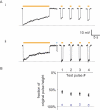Multiple-color optical activation, silencing, and desynchronization of neural activity, with single-spike temporal resolution
- PMID: 17375185
- PMCID: PMC1808431
- DOI: 10.1371/journal.pone.0000299
Multiple-color optical activation, silencing, and desynchronization of neural activity, with single-spike temporal resolution
Abstract
The quest to determine how precise neural activity patterns mediate computation, behavior, and pathology would be greatly aided by a set of tools for reliably activating and inactivating genetically targeted neurons, in a temporally precise and rapidly reversible fashion. Having earlier adapted a light-activated cation channel, channelrhodopsin-2 (ChR2), for allowing neurons to be stimulated by blue light, we searched for a complementary tool that would enable optical neuronal inhibition, driven by light of a second color. Here we report that targeting the codon-optimized form of the light-driven chloride pump halorhodopsin from the archaebacterium Natronomas pharaonis (hereafter abbreviated Halo) to genetically-specified neurons enables them to be silenced reliably, and reversibly, by millisecond-timescale pulses of yellow light. We show that trains of yellow and blue light pulses can drive high-fidelity sequences of hyperpolarizations and depolarizations in neurons simultaneously expressing yellow light-driven Halo and blue light-driven ChR2, allowing for the first time manipulations of neural synchrony without perturbation of other parameters such as spiking rates. The Halo/ChR2 system thus constitutes a powerful toolbox for multichannel photoinhibition and photostimulation of virally or transgenically targeted neural circuits without need for exogenous chemicals, enabling systematic analysis and engineering of the brain, and quantitative bioengineering of excitable cells.
Conflict of interest statement
Figures







References
-
- McCormick DA, Thompson RF. Cerebellum: essential involvement in the classically conditioned eyelid response. Science. 1984;223:296–299. - PubMed
-
- Shaw BK, Kristan WB., Jr. Relative roles of the S cell network and parallel interneuronal pathways in the whole-body shortening reflex of the medicinal leech. J Neurophysiol. 1999;82:1114–1123. - PubMed
-
- Koch C. 2004. The Quest for Consciousness: A Neurobiological Approach Roberts & Company Publishers
-
- Kandel ER, Schwartz JH, Jessell TM. 2000. Principles of Neural Science: McGraw-Hill Medical. p. 1414 p.
Publication types
MeSH terms
Substances
LinkOut - more resources
Full Text Sources
Other Literature Sources
Research Materials

